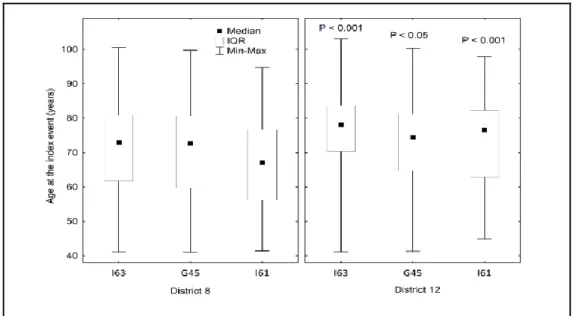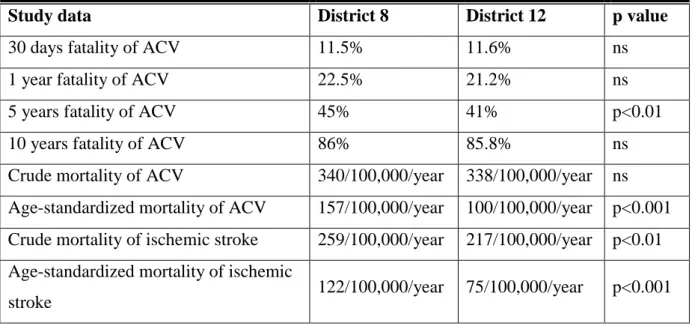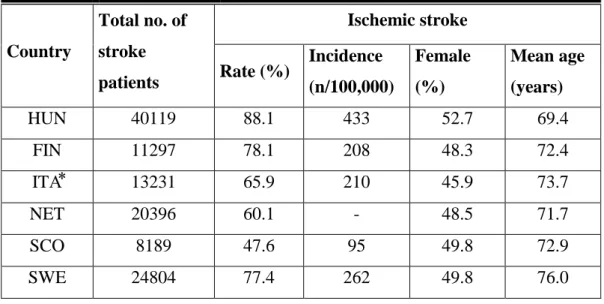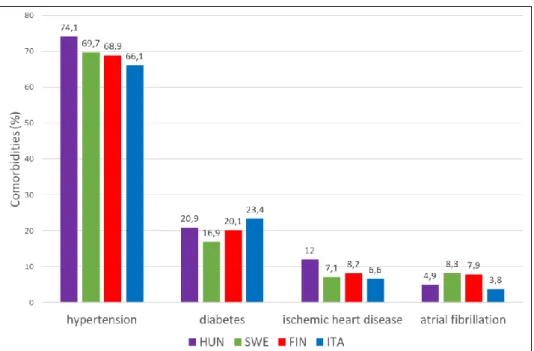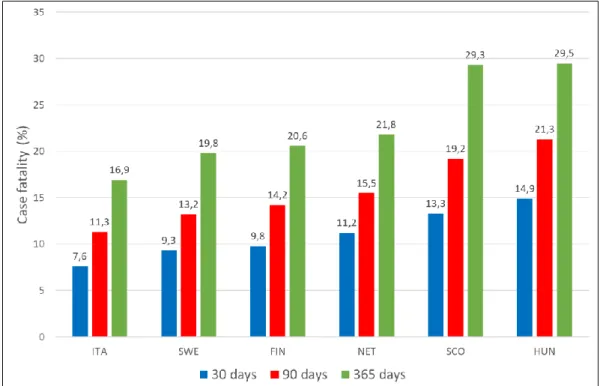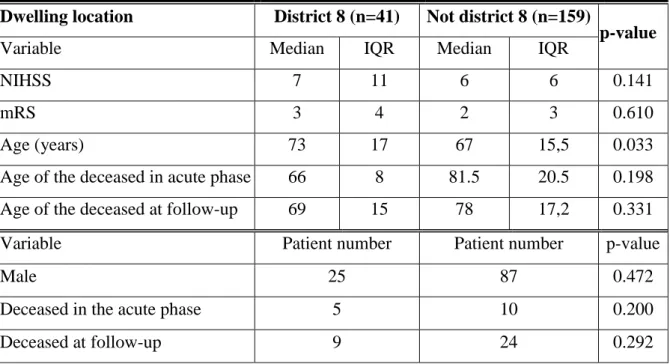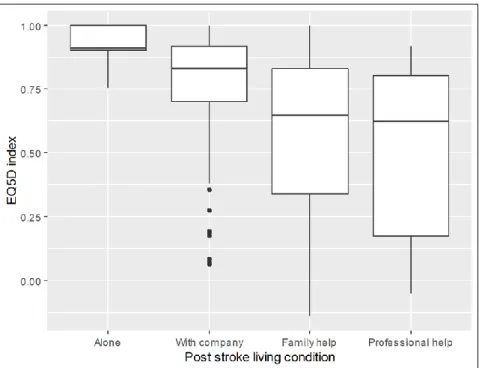1
The role of socioeconomic deprivation in the incidence and outcome of stroke in Budapest
PhD thesis
Ildikó Szőcs, MD
Semmelweis University
Neurosciences („János Szentágothai”) School of PhD Studies
Supervisor: Ildikó Vastagh, MD, PhD Consultant: Dániel Bereczki, MD, DsC
Official reviewers: Levente Kerényi, MD, PhD György Purebl, MD, PhD
Head of the Final Examination Committee:
Ferenc Rozgonyi, MD, DsC Members of the Final Examination Committee:
Ágnes Szirmai, MD, PhD Attila Valikovics, MD, PhD
Budapest
2019
2
INTRODUCTION
Even in the XXI. century, stroke is still one of the leading causes of mortality and disability.
In Hungary - among other Eastern European countries –a declining tendency of the incidence and mortality of stroke might be observed. Despite this tendency, the standard death rate of cerebrovascular diseases reported for Hungary is still 1.5 times higher than the average value of the European Union (63/100,000 versus 42/100,000, both sexes, all ages, World Health Organization. European Health Information Gateway, Health for All Explorer, Fig 1).
Figure 1. The standard death rate of cerebrovascular diseases in Hungary and the Members of the European Union (both sexes, all ages, World Health Organization.
European Health Information Gateway, Health for All Explorer)
The reason behind Hungary’s fallback is quite complex, but it might be simplified to socioeconomic deprivation (Dalstra et al 2005). Socioeconomic deprivation is widely known to increase stroke risk (World Health Organization. Cardiovascular risk factors – data and statistics). Nevertheless, the way and the extent to which the socioeconomic condition influences the stroke risk of the Hungarian population is barely known (Folyovich et al 2015, WHO Health Profile Hungary 2017, Bereczki et al 2014, Józan 1998).
3
AIM
As a neurologist working with stroke patients, I have experienced with my colleagues that stroke burden does not seem to affect patients coming from different neighborhoods equally.
The studies described in this thesis are all rooting from this experience.
We aimed to study – prove or confute – whether stroke incidence and outcome is influenced by provenance from socioeconomically different regions of the country. We also set out to study exactly which stroke parameters are poorer in Hungary in international comparison. We were also interested in the possible effect of socioeconomic differences on quality of life (QoL) after stroke and on patient satisfaction with the care received.
We have performed three studies to meet the above mentioned aims. The first study – described in the chapters titled Stroke epidemiology in the districts of Budapest – was a retrospective longitudinal study collecting the data of almost 5,000 patients. In this study my tasks were the following: maintenance of the database, data analysis in part, interpretation of statistical results, drafting the manuscript and oral presentation of the results on different scientific fora. The second study – detailed in the chapters titled International stroke study in the frame of the EuroHOPE project – creates an international database using data of the already available national hospital-based registries. In this study my tasks were: interpretation of data, drafting the manuscript, oral presentation of the results on scientific meetings. The third study – described in the chapters under the heading Studying quality of life after stroke in the frame of the EuroHOPE project - assesses two hundred patients via personal examination, interviews and follow-up. In this study I was responsible for the enrollment, examination and follow-up of the patients, creation and maintainance of the database, interpretation of the statistical results, oral presentation and the first draft of the manuscript.
METHODS
Stroke epidemiology in the districts of Budapest
Study setting
Our data about the stroke patients were provided by the National Health Insurance Fund of Hungary (NHIF). Data regarding the districts of the capital were obtained from the Hungarian Central Statistical Office (CSO). The latter provides annually a hierarchical list of the districts based on the annual taxable income. The two districts selected for the study are invariably recorded on the two ends of the list: District 8 among the poorest and District 12 among the
4
richest districts of the capital (CSO. Statistical Yearbook of Hungary 2016). As to the demographical data of the districts, there aren’t any significant differences.
Study plan
After obtaining ethical consent from the Semmelweis University Ethical Committee (registry no: 88/2015), in the frame of a retrospective observational cohort study, we have collected the data of the patients coming from District 8 or 12 who have suffered acute cerebrovascular disease between January 2002 and December 2007. Acute cerebrovascular disease (ACV) was defined as ischemic or hemorrhagic stroke or transient ischemic attack (TIA). Follow-up was performed until March of 2013 for recurrence, hospital readmission, newly diagnosed associated diseases and fatalities. In order to increase the probability of creating a cohort of acute cases, we have ruled out those patients who were hospitalized for ischaemic or haemorrhagic stroke during the two years before the index event (Szőcs et al 2019).
Statistical analysis
Normality of continuous variables was assessed by the Shapiro-Wilk test. Age at the index event was compared between the two districts by the Mann-Whitney test. Incidence and mortality were tested by z-scores. Acute and long-term fatalities were compared between the districts by the chi-square test. Direct standardization was used to calculate age-standardized incidence and mortality, using the 2013 European Standard Population for standardization (Eurostat 2013). Spearman-correlation was applied to study the relationship between the age of the patients at the index event and the annual taxable income of the corresponding district (serving as dwelling location for the respective patient). Statistical significance was set at p<0.05. Statistica for Windows 12 was used for statistical analysis (Statsoft, Tulsa, OK).
International stroke study in the frame of the EuroHOPE project
The EuroHOPE project
The European Healthcare Outcomes, Performance and Efficiency (EuroHOPE) project is an international program which created a database suitable for international comparison based on the national hospital-based registries of individual patient-data in six European countries in several subjects. Out of these subjects, during studying stroke data, I took part in two processes. In this chapter I will present the epidemiological data of stroke patients from six countries (Szőcs et al 2016, Belicza et al 2016). In the next chapter I am going to expose the substudy of quality of life and patient satisfaction of Hungarian stroke patients.
5 Study setting
We have performed a retrospective analysis of stroke data of six European countries. These countries were: Hungary (HUN), Finland (FIN), Sweden (SWE), the Netherlands (NET), Italy (ITA, Lazio region and Torino), the United Kingdom/Scotland (SCO). Hungarian data were collected for the years 2005 to 2009. International comparison was completed for the year of 2008.
Study plan
We have used the data of the hospital registries and fatalities of the stroke patients centralized in the database of the NHIF. We have enlisted those patients above 18 years, who were admitted into an acute hospital with the main diagnosis of I60, I61, I63, I64 based on the International Classification of Diseases-10. We have ruled out those who were admitted with the same diagnostic codes into any hospital in the year preceding the index event. We have recorded the associated diseases from the hospital registries and also based on the drug-use of prescription drugs of the year before the index event. Data regarding fatalities were not specific to stroke – thus we do not have data of stroke fatality, rather about fatality of stroke patients. We have also procured data of drug-use of prescription drugs in four categories.
These were: antithrombotic drugs, drugs used against hypertension, diabetes and dyslipidemia. The first group contains data of clopidogrel, dipyridamole and warfarin.
Unfortunately, we could not collect data of over-the-counter drugs (like aspirin) or drugs that weren’t approved in each country (like acenocumarol).
Statistical analysis
To be able to perform multiple-testing analysis, the EuroHOPE consortium provided the Stata software. For evaluating fatalities and drug-use, age and gender were introduced as control variables in the multiple logistic regression model. Statistical significance was set at p<0.05.
Studying quality of life after stroke in the frame of the EuroHOPE project
Study setting
The study was a longitudinal prospective study evaluating the quality of life and satisfaction with the care received of two hundred patients admitted for ischemic stroke to the Department of Neurology of the Semmelweis University.
Study plan
We have obtained ethical consent from Semmelweis University Regional and Institutional Committee of Science and Research Ethics (registration no: 98/2012). In each case we have asked for individual consent from the patient or the caretaker. We have collected social,
6
demographical and medical data. Follow-up was performed personally three months after stroke reassessing medical data and social factors, evaluating quality of life and patient satisfaction. We have also documented information regarding hospital readmission of any causes (rehabilitation, carotid reconstruction, recurrence, etc.).
Data collection instruments
We have evaluated the quality of life of patients using the EQ-5D-5L questionnaire developed by the EuroQoL workgroup (EQ5D, EuroQoL Group, The EQ5D5L Questionnaire, 2015) and the HRQoL 15D questionnaire developed by Harri Sintonen (Q15D, Sintonen 1995). Patient satisfaction with the care received was examined by the EORTC IN-PATSAT32 questionnaire (PATSAT) developed by the European Organization for Research and Treatment of Cancer (EORTC QOL Group: EORTC-PATSAT32, 2005). Each of these three questionnaires was subject to linguistic validation to enhance the reliability of the results.
Statistical analysis
When analyzing the relationship of two variables, we have used the following statistical tools:
correlation-analysis (Pearson, Kendall, Spearman), Kruskal-Wallis test, Mann-Whitney-test and chi-square test. To build the complex statistical models, we have used multiple regression analysis. To study acute and three-month fatality, we have used linear regression.
RESULTS
Stroke epidemiology in the districts of Budapest
General data
The total number of patients above 40 years of age, admitted for novel ACV between 2002 and 2007 from Districts 8 or 12, was 4779. As to gender, 58% were female and 42 % were male. 2618 patients came from District 8, 2161 from District 12. The two groups did not differ in the distribution of diagnostic types. Until the end of follow-up (March 2013), 57% of patients passed away.
Incidence of acute cerebrovascular disease and of ischemic stroke
Crude incidence of ACV was somewhat lower in District 8 compared to District 12 (572/100,000/year versus 623/100,000/year). The age-standardized value was significantly higher in District 8, though (680/100,000/year versus 518/100,000/year). Analyzing only the data of ischemic stroke, both crude and age-standardized incidence were higher in District 8.
7 Analyzing the effect of age
Average age at the onset of the index event
The age of patients from District 8 was 69,7±13,3 years at the ACV, while that of District 12 patients was 73,3±12,4 year (Mann-Whitney-test p<0.05). We have found a similar result in all three subgroups of ACV. The average age of the District 8 patients suffering TIA, ischemic or hemorrhagic stroke was significantly lower than that of the District 12 patients (Fig 2).
Figure 2. Age at onset of ischemic stroke, intracerebral hemorrhage and transient ischemia in the two districts. G45=transient ischemia, I63=ischemic stroke, I61=intracerebral hemorrhage. Statistical significance was calculated with Mann-Whitney test for each diagnostic category between the districts.
Incidence in the younger and older groups
Examining the patients in decades of age subgroups, we have found that in the younger age- groups (5th and 6th decade) ACV incidence was higher in District 8 than in District 12, while the opposite was true for the elderly groups (decades 8th and 9th, Fig 3). Similar result was obtained when constraining the analysis to ischemic stroke.
Correlation of age at stroke and income
As we have found that stroke occurs at significantly younger ages in the poorer District 8, we decided to examine this correlation in a wider perspective. In frame of an ongoing national stroke project, we have collected data of ischemic stroke patients for more than ten years from all 23 districts of the capital (Oberfrank et al 2018). The result showed that the lower the
8
annual taxable income is in the respective district, the younger the patients are at the onset of the stroke (Fig 4., p<0.001).
Figure 3. Crude incidence of ACV (ischemic stroke, intracerebral hemorrhage, transient ischemic attack) in the two districts in the different age groups. Two-sided p values for z- score: ***p<0.001.
Fig 4. Association of the mean age at onset of ischemic stroke with annual taxable income of the 23 districts of Budapest. Each point represents the mean values for one district. Spearman R= 0.82, p < 0.001.
9
Outcome of acute cerebrovascular disease and ischemic stroke Case fatality
Case fatality at 30 days, 1 year, 10 years did not differ between the two districts (fatality at 5 years after stroke was higher in District 8, Table 1). We have also examined the data dividing the patients in age-groups. Acute ACV fatality was significantly higher in District 8 patients in their 5th and 7th decade of age compared to the same-age District 12 fellows (p<0,05 and p<0,01), while there was no difference in the rest of the age-groups (Fig 5). During long-term follow-up, we have noticed that the gap between fatality of the younger groups from the two districts increases until the 1, 5 and 10 years’ follow-up. Differently put, in the 5th, 6th and 7th decade groups, the fatality of District 8 patients worsens more as time passes than that of District 12. As to ischemic stroke, a similar result was obtained, stressing the disadvantage of the younger District 8 patients, too.
Mortality
Crude mortality of ACV patients was 340/100000/year in District 8 and 338/100000/year in District 12. Age-standardized incidence of both ACV and ischemic stroke was significantly higher in the District 8 group (Table 1).
Table 1. Case fatality and mortality of ACV and ischemic stroke in the two neighborhoods
Study data District 8 District 12 p value
30 days fatality of ACV 11.5% 11.6% ns
1 year fatality of ACV 22.5% 21.2% ns
5 years fatality of ACV 45% 41% p<0.01
10 years fatality of ACV 86% 85.8% ns
Crude mortality of ACV 340/100,000/year 338/100,000/year ns Age-standardized mortality of ACV 157/100,000/year 100/100,000/year p<0.001 Crude mortality of ischemic stroke 259/100,000/year 217/100,000/year p<0.01 Age-standardized mortality of ischemic
stroke 122/100,000/year 75/100,000/year p<0.001
Risk diseases
The prevalence of cardiovascular diseases (hypertension, atrial fibrillation, arrhythmia, ischemic heart disease, heart failure) in District 8 patients in their 5th, 6th and 7th decades of
10
age exceeds that of their fellows from District 12. The trendlines cross over in the seventies and above 80, the prevalence of the cardiovascular diseases is higher in District 12 (Fig 6).
Figure 5. The difference by which the fatality of acute cerebrovascular disease patients of District 8 exceeds that of District 12 in the different age-groups. Value of District 8 minus the value of District 12. Chi-square test. *p<0.05, **p<0.01, ***p<0.001.
Figure 6. Mean number of associated cardiovascular diagnoses per 1,000 ischemic stroke patients of the two districts in 10-year age groups. Patients dwelling in District 8 being 41-50 years of age at ischemic stroke onset have a vascular disease burden as high as their 12 years’ older fellows from District 12.
11
International stroke study in the frame of the EuroHOPE project
Incidence
Comparison of the data from the six countries was performed for data of 2008 (Table 2).
Hungary reaches the poorest results in all categories: highest ischemic stroke incidence, lowest age of patients at disease onset.
Related to the rest of the countries, Scotland showed low number of patients involved, low incidence of ischemic stroke and low rate of ischemic stroke out of the total number.
Incidence could not have been calculated in the Netherlands, because not all hospitals participated in the study. The low stroke patient number in Italy is attributable to the exclusive participation of the Lazio region and Torino. Nevertheless, even in Italy the ischemic stroke incidence was corrected and calculated with regard to the total population of the country, hence it is comparable with the corresponding values of the other countries.
Table 2. Stroke patients treated in hospital in 2008 in Hungary and five other European countries. ITA⃰: Lazio region and Torino participated in the study. Ischemic stroke incidence was calculated for the entire population for the respective countries
Risk diseases
Risk diseases recorded could be collected in the year before the index stroke only in those countries where a uniform standardized drug-supply database existed. Thus we present data of four countries only. The prevalence of risk diseases in the year preceding the index stroke does not differ among the countries to a major extent (Figure 7).
Country
Total no. of stroke patients
Ischemic stroke Rate (%) Incidence
(n/100,000)
Female (%)
Mean age (years)
HUN 40119 88.1 433 52.7 69.4
FIN 11297 78.1 208 48.3 72.4
ITA⃰ 13231 65.9 210 45.9 73.7
NET 20396 60.1 - 48.5 71.7
SCO 8189 47.6 95 49.8 72.9
SWE 24804 77.4 262 49.8 76.0
12
Figure 7. Risk diseases of ischemic stroke patients recorded in the year before the stroke. Comorbidities were assessed using hospital registries and drug-supply registries of prescription drugs.
Case fatality
Comparison of fatality data was possible for all six countries. Fatality was the highest in Hungary for each of the three time-periods but the disadvantage compared to the other countries was even more spectacular for the later follow-ups (90 and 365 days after stroke, Fig 8).
Drug-use after ischemic stroke
Data regarding drug-use in the year after the stroke could be collected only for the prescription-drugs and only in the countries having a centralized drug-registry. In this analysis, there is a noticeable difference between the countries. In case of ischemic stroke, the most important drugs of secondary prevention are the antithrombotic drugs. For the causes already detailed in the Methods section, data about aspirin and acenocumarol use could not be collected. This might distort the results. Still, the most prevalent antithrombotic drug-use – that of Finland’s – exceeds that of Hungary’s threefold. In case of lipid lowering medication, twice as many Finnish patients bought these compared to the Hungarian patients. Concerning the groups of antihypertensives and antidiabetics, the difference is less important, but Hungary shows still the lowest drug-use (Fig 9).
13
Figure 8. Fatality of ischemic stroke patients in the six European countries at 30, 90 and at 365 days. Data were corrected for age and gender.
Figure 9. Drug-use of ischemic stroke patients in the year after the stroke onset. Data were corrected for age and gender.
14
Studying quality of life after stroke in the frame of the EuroHOPE project
General data
The general description of the two hundred patients studied can be seen in Table 3. Almost all parameters demonstrate the worse state of health of the patients coming from District 8: their NIHSS score showing neurological state on admittance and the mRS score measuring the disability at discharge are higher, the age of the deceased is younger. These differences were not found significant, probably due to the low number of patients per subgroup.
Table 3. General data of the 200 patients studied. Statistics: Mann-Whitney test for age and NIHSS, chi-square for patient numbers and mRS scores. NIHSS: National Institute of Health Stroke Scale, mRS: modified Rankin Score.
Dwelling location District 8 (n=41) Not district 8 (n=159)
p-value
Variable Median IQR Median IQR
NIHSS 7 11 6 6 0.141
mRS 3 4 2 3 0.610
Age (years) 73 17 67 15,5 0.033
Age of the deceased in acute phase 66 8 81.5 20.5 0.198
Age of the deceased at follow-up 69 15 78 17,2 0.331
Variable Patient number Patient number p-value
Male 25 87 0.472
Deceased in the acute phase 5 10 0.200
Deceased at follow-up 9 24 0.292
Case fatality. Age at death
The rate of the patients deceased during acute management was 15/200 (7,5%). We haven’t found any difference between the number of the deceased dwelling in District 8 or elsewhere (chi-square: p-value = 0,201). Patients deceased in the acute phase and dwelling in District 8 were by 11 years younger than the patients dwelling elsewhere. This age-difference was not significant, though, due to the low number of patients (Mann-Whitney test, p= 0,198). Results were similar for the subgroup of patients deceased at 90 days follow-up, too.
Quality of life
We have succeeded to assess the quality of life in 81% of patients (136 patients were alive, able and willing to answer, 7 were comatose or severely demented, 24 declined to answer).
15
The control variables were: age, gender, education, NIHSS at admittance and mRS at discharge. In the statistical models with multiple variables we have corrected the effect of patient satisfaction, too. In the multiple regression models we found the following variables to have a significant effect on quality of life measured as EQ5D three months after stroke: age, mRS at discharge, stroke type by TOAST, patient satisfaction, acute and postacute length-of- stay, social type of dwelling after stroke. Working status before stroke had a marginal effect on quality of life.
Those patients reported the best quality of life, who were able to live on their own in their home, lower values were reported by those who lived with company, even lower by those who needed family or professional help (Fig 10).
The postacute length of stay also proved to be an independent predictor of EQ5D: the longer the LOS, the worse the QoL of patients. This effect was especially strong for LOS longer than 30 days (Fig 11).
The patients’ satisfaction with the care received
When examining patient satisfaction, control variables were age, gender, education, marital status, NIHSS and mRS. We have corrected for the effect of QoL in all models built for patient satisfaction. In multiple variable analysis, EQ5D index was an independent predictor of the global PATSAT score, and of all three subgroups of patients’ satisfaction. When performing the multiple ordinal logistic regression model analysis on global patient satisfaction (the index score of the PATSAT questionnaire), we have found that the severity of stroke at onset (NIHSS at admittance) decreased while having thrombolysis and better EQ5D scores increased patient satisfaction. Those patients who underwent thrombolysis were also more satisfied with the nurses. We have examined all the parameters assessed in the study, but the rest of the variables did not have any effect on patient satisfaction or its sub- items.
16
Figure 10. EQ5D index by living condition. Kruskal-Wallis chi-squared test p-value<0.001.
Middle line: median, box borders: interquartile range (IQR), whiskers: range of non-outlier values, points: outliers in Tukey’s sense (at least 1.5*IQR distance from the lower or upper quartile), outliers were taken into account when calculating the median and IQR).
Figure 11. EQ5D index by post-acute LOS. Kruskal-Wallis chi-squared test p-value<0.001.
Middle line: median, box borders: interquartile range (IQR), whiskers: range of non-outlier values, points: outliers in Tukey’s sense (at least 1.5*IQR distance from the lower or upper quartile), outliers were taken into account when calculating the median and IQR).
17
CONCLUSIONS
Stroke epidemiology in the districts of Budapest
In the study comparing stroke data of the poorest and the richest neighborhoods of Budapest, we have found that stroke hits at younger age, with higher incidence and mortality in the poorest district compared to the richest one. The cardiovascular disease burden is higher in the younger groups of District 8 and in the elderly groups of District 12. General and metabolic disease burden was also higher among the young of District 8. The findings regarding case fatality are interesting: although District 8 patients are younger on average, their global fatality is still similar to that of the District 12 group. At examining these correlations in age subgroups, we observed that the younger groups of District 8 show higher early fatality than the same-age District 12 groups. This gap between the poor and rich populations grows larger with time passing during follow-up: the fatality of the younger groups of District 8 worsens more than the fatality of the same-age District 12 group until the 1, 5, and 10 years’ follow-up. It’s as if the younger dwellers of District 8 would have a more advanced biologic age under the burden of comorbidities than their same-age fellows from District 12 even before the stroke. After the stroke the process seems to fasten up, as if the District 8 patients would grow old faster, showing higher rate of fatalities at follow-up than their more fortunate fellows from District 12.
International stroke study in the frame of the EuroHOPE project
Out of the six European countries assessed, ischemic stroke incidence, fatality at 30, 90 and 365 days was the highest in Hungary. The prevalence of risk diseases recorded in the year before the stroke does not show striking differences among the countries, so it does not explain the incidence being the highest in Hungary. It is sad, though, that despite the high incidence and early fatality, the Hungarian value of drug-use after the stroke is by far lower than in the other countries. This low drug-use might at least partially explain the late fatality being the highest in our country. The fact that the risk diseases probably remain unrecognized before the stroke points to the inefficacy of primary prevention, while the high late fatality and low rate of drug-use suggest the deficiency of the secondary prevention.
Studying quality of life after stroke in the frame of the EuroHOPE project
The length of stay in acute or postacute hospital care decreased the quality of life of our patient group. Dwelling condition after stroke (living with company, needing family or
18
professional help or being able to live alone) also influenced significantly the quality of life.
These findings raise the question whether the long-term outcome could be improved further by intensifying in-hospital rehabilitation or by creating outpatient facilities to aid the patients and the caretakers. It would be important to study the effect of early discharge to patients’
home facilitated by outpatient rehabilitation on the later quality of life of patients.
Patient satisfaction was influenced negatively by stroke severity and positively by thrombolysis and better QoL.
Publications
Publications underlying the dissertation
1. Szőcs I, Bereczki D, Ajtay A, Oberfrank F, Vastagh I. (2019) Socioeconomic gap between neighborhoods of Budapest: Striking impact on stroke and possible explanations. PLoS ONE, 14(2): e0212519.
2. Szőcs I, Bereczki D, Belicza É. (2016) Results of stroke care in Hungary in the frame of international comparison [A stroke-ellátás hazai eredményei a nemzetközi adatok tükrében]. Orv Hetil, 157(41): 1635-1641.
3. Szőcs I, Szatmári S, Fekete K, Orbán-Kis K, Vastagh I, Folyovich A, Ajtay A, Bereczki D. (2012) One-year follow-up after stroke. A preliminary feasibility study in Josephtown of Budapest [Egyéves követéses vizsgálat stroke után: megvalósíthatósági előtanulmány a budapesti Józsefvárosban]. Ideggyogy Sz, 65: 107-112.
4. publikációra benyújtva:
Szőcs I, Dobi B, Lám J, Bereczki D, Orbán-Kis K, Häkkinen U, Belicza É, Vastagh I. The impact of social factors on stroke fatality, quality of life and patient satisfaction: a follow-up study in Budapest
Publications on the same topic
1. Orosz P, Szőcs I, Rudas G, Folyovich A, Bereczki D, Vastagh I. (2018) Cortical Hand Knob Stroke: Report of 25 Cases. J Stroke Cerebrovasc Dis, 27(7): 1949-1955.
2. Orbán-Kis K, Szőcs I, Fekete K, Mihalka L, Csiba L, Bereczki D, Szatmári S. (2016) Comparison of hospitalized acute stroke patients’ characteristics using two large Central- Eastern European databases. Ideggyogy Sz, 69(1–2): 47–53.
3. Fekete K, Szatmári Sz, Szőcs Sz, Szekeres Cs, Szász J, Mihálka L, Smolanka V, Kardos L, Csiba L, Bereczki D. (2014) Prestroke alcohol consumption and smoking are not associated with stroke severity, disability at discharge and case fatality. J Stroke Cerebrovasc Dis, 23(1):
e31-37.
19
4. Szőcs I, Bereczki D, Orbán-Kis K, Szász JA, Győri LF, Szatmári S. (2012) The influence of acute phase blood pressure on stroke outcome: to treat or not to treat? Acta Medica Marisiensis, 58(1): 66-69.
5. Orbán-Kis K, Szőcs I, Szatmári Sz. (2011) The Impact of Modifiable Risk Factors on Short- term Outcome of Stroke. Acta Med Marisiensis, 57(4): 324-327.
6. Szőcs I, Kinda K, Orbán-Kis K, Bajkó Z, Szász JA, Szatmári S. (2007) Mannitol in the management of stroke. [A mannitol használata a stroke kezelésében]. Bulletin of Medical Sciences / Orvostudományi Értesítő, 80(3): 194-197.
Other publications
1. Szász JA, Szőcs I, Lökös EM, Boros S, Miklós Z, Márk LF, Szatmári S. (2004) Motor fluctuations in late-phase Parkinson’s disease [Motoros teljesítményingadozások a Parkinson- kór késői fázisában]. Orvostudományi Értesítő – Bulletin of Medical Sciences, 77(3): 357- 360.
2. Szőcs I, Szász JA, Szombathelyi É, Szatmári S. (2003) Cognitive decline and affective disorders in reflection of motor fluctuations in Parkinson’s disease patients [Parkinson kóros betegek szellemi hanyatlása és affektív zavarai a mozgásteljesítmény függvényében].
Orvostudományi Értesítő - Bulletin of Medical Sciences, 76(2): 161-164.
3. Szőcs I, Szász JA, Szatmári S. (2002) Neuropsychological profile versus motor status and treatment strategies in Parkinson’s disease patients [A Parkinson kóros betegek pszichés státusának vizsgálata a klinikai kép és a kezelési stratégiák függvényében]. Orvostudományi Értesítő - Bulletin of Medical Sciences, 75(4): 461-464.
4. Szász JA, Szőcs D, Szatmári S, Szőcs I, Brassai C. (2002) New dopa-agonists in the management of Parkinson’s disease [Az új dopa-agonisták jelentősége a Parkinson-kór kezelésében]. Orvostudományi Értesítő - Bulletin of Medical Sciences, 75(3): 333-336.
5. Wilhelm I, Szőcs I, Orbók A, Jakab P. (2002) Depressive disorders and its social background – an assessment among the Hungarian population of Romania [A depressziós tünetegyüttes és társadalmi háttértényezői (felmérés a romániai magyar lakosok körében)]. Orvostudományi Értesítő - Bulletin of Medical Sciences, 75(4): 465-470.

